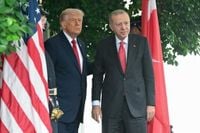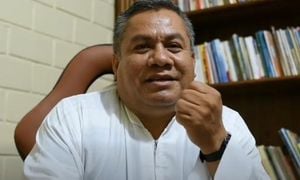In a significant diplomatic breakthrough, U.S. President Donald Trump announced on October 7, 2025, that Hamas has agreed to major conditions in the ongoing Gaza ceasefire talks, raising hopes for a long-awaited peace in the war-torn enclave. Speaking from the Oval Office, Trump described the negotiations as progressing favorably and credited a broad coalition of regional partners, particularly Turkey, for their essential roles in moving the process forward. The mood, for the first time in years, seemed cautiously optimistic.
The announcement followed indirect talks that began the previous day in Egypt between Hamas and Israeli delegations, held under the auspices of Trump’s administration and guided by a new 20-point plan. According to reporting by multiple outlets, the plan’s central pillars include the release of Israeli captives in exchange for Palestinian prisoners, the disarmament of Hamas, and a robust framework for the reconstruction of the Gaza Strip. Trump revealed that Hamas has already agreed to these provisions in principle, marking a notable shift in the group’s public posture.
“President Erdogan is fantastic, he has been pushing very hard for this deal,” Trump told reporters, as cited by BBC and other international news organizations. “He is a very powerful guy, Hamas has a lot of respect for him.” Trump’s praise for Turkey’s President Recep Tayyip Erdogan was echoed throughout his remarks, as he underscored the importance of regional buy-in. “Hamas holds considerable respect for Turkey, Qatar, the UAE, and Saudi Arabia,” Trump said, highlighting the coalition that has assembled to support the peace initiative.
The president’s optimism was unmistakable. “I think we’re going to have a deal. It’s a hard thing for me to say that when for years and years they’ve been trying to have a deal,” Trump remarked. “We’re going to have a Gaza deal, I’m pretty sure, yeah.” Yet he was careful to note that certain preconditions remain, declining to specify whether the disarmament of Hamas was a non-negotiable element. “I have red lines, if certain things aren’t met we’re not going to do it,” he said. “But I think we’re doing very well and I think Hamas has been agreeing to things that are very important.”
The indirect nature of the talks is not new—in fact, it’s a hallmark of the decades-long Israeli-Palestinian conflict. Both sides have historically refused to engage in direct negotiations, relying instead on mediators to shuttle messages and proposals back and forth. This time, Egypt and Qatar have reprised their roles as primary intermediaries, hosting delegations and facilitating communication between the parties. The United States, under Trump’s leadership, has stepped up its involvement, while Turkey has emerged as a particularly influential voice, advocating for international engagement and humanitarian access for Gaza’s beleaguered civilian population.
Trump’s remarks also addressed speculation about his relationship with Israeli Prime Minister Benjamin Netanyahu. Some reports had suggested tension between the two leaders over the negotiation process, but Trump was quick to dispel those rumors. “Netanyahu has been very positive about the deal,” he clarified, pushing back against suggestions of discord. The need for unity among allies is clear, given the high stakes and the fragile nature of any potential agreement.
The 20-point plan at the heart of the negotiations has not been fully disclosed to the public, but its main objectives are clear: to secure the release of hostages and prisoners on both sides, to chart a course for the disarmament of Hamas, and to lay the groundwork for rebuilding Gaza after a year of devastating conflict. According to Al Jazeera and other regional outlets, previous ceasefire efforts have repeatedly stalled over disagreements on these very issues—prisoner exchanges, withdrawal timelines, and guarantees for reconstruction. The most recent attempts in late 2024 collapsed amid disputes about the release of hostages and Palestinian prisoners, highlighting just how fraught the process remains.
Hamas’s willingness to embrace the new framework, even in principle, represents a significant shift. The group has long resisted disarmament and has been wary of international oversight in Gaza’s reconstruction. But the scale of destruction in the enclave—described by the United Nations as “catastrophic”—and the mounting humanitarian crisis have increased pressure on all parties to find a solution. Regional powers, particularly Turkey, have been vocal in urging continued international involvement and emphasizing the urgent need for humanitarian aid and reconstruction support for Gaza’s civilians.
“The parties are very, very close to finalizing an agreement,” Trump said, expressing hope that the deal could extend peace beyond Gaza to the wider Middle East. The president’s confidence is buoyed by the apparent alignment of interests among key regional actors, all of whom have a stake in stabilizing the situation and preventing further escalation.
Still, the road ahead is far from certain. Indirect negotiations are inherently fragile, and the history of broken ceasefires in Gaza is a sobering reminder of the challenges that remain. The involvement of multiple mediators—Egypt, Qatar, and now Turkey—reflects both the complexity of the conflict and the international community’s determination to see it resolved. Trump’s administration, for its part, has staked considerable political capital on achieving a breakthrough, with the president personally invested in the outcome.
Observers caution that while the momentum is encouraging, the devil is in the details. The specific terms of prisoner exchanges, the mechanisms for disarmament, and the guarantees for reconstruction will all need to be hammered out in the coming days. Any misstep or breakdown in trust could derail the process, as has happened so many times before. Nonetheless, the current round of talks feels different, if only because so many previous attempts have ended in failure and the costs of continued conflict have become unbearable for Gaza’s civilians.
As negotiations continue behind closed doors in Cairo, the eyes of the world remain fixed on the outcome. The prospect of a durable ceasefire and the beginning of reconstruction in Gaza offers a glimmer of hope in a region long plagued by violence and mistrust. Whether this moment will mark a true turning point depends on the willingness of all parties to make difficult compromises—and on the ability of mediators to keep the process on track.
For now, the message from Washington is clear: a deal is within reach, and with the support of regional partners, the possibility of lasting peace in Gaza—and perhaps beyond—has never seemed more real.




